Creating the World That’s Possible – One Community Weekly Progress Update #573
One Community is creating the world that’s possible through sustainable approaches to food, energy, housing, education, economics, and social architecture. Our all-volunteer team is dedicated to pioneering fulfilled living and global stewardship practices. With a model designed for “The Highest Good of All,“we’re open sourcing and free sharing the complete process, aiming to regenerate our planet and create a world that works for everyone. This model, created by an all-volunteer team, will be used to create a global collaboration of teacher/demonstration hubs, ensuring our efforts become self-replicating.
- Here’s our project overview
- Here’s our world-change methodology
- Here’s how this becomes self-replicating
- Here’s how we are open source and free-sharing all the do-it-yourself designs
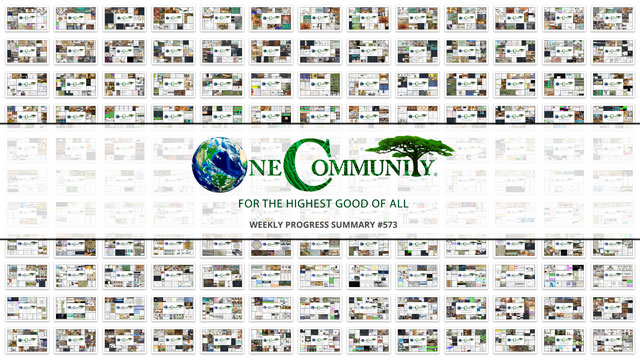
OUR MAIN OPEN SOURCE HUBS
Click on each icon to be taken to the corresponding Highest Good hub page.
One Community’s physical location will forward this movement for creating the world that’s possible as the first of many self-replicating teacher/demonstration communities, villages, and cities to be built around the world. This is the March 11th, 2024 edition (#573) of our weekly progress update detailing our team’s development and accomplishments:
Creating the World That’s Possible
One Community Progress Update #573
DONATE | COLLABORATE | HELP WITH LARGE-SCALE FUNDING
CLICK HERE IF YOU’D LIKE TO RECEIVE AN EMAIL EACH WEEK WHEN WE RELEASE A NEW UPDATE
YOU CAN ALSO JOIN US THROUGH SOCIAL MEDIA
ONE COMMUNITY WEEKLY UPDATE DETAILS
HIGHEST GOOD HOUSING PROGRESS
 One Community is creating the world that’s possible through Highest Good housing that is artistic and beautiful, more affordable, more space efficient, lasts longer, DIY buildable, and constructed with healthy and sustainable materials:
One Community is creating the world that’s possible through Highest Good housing that is artistic and beautiful, more affordable, more space efficient, lasts longer, DIY buildable, and constructed with healthy and sustainable materials:
-
-
- Learn about: Our Upcoming Crowdfunding Campaign
- Learn about the different village models: 7 Sustainable Village Models
- Visit the open source portals for the first two: Earthbag Village OS Hub | Straw Bale Village OS Hub
-
This week, a core team member did their final review of the DIY Murphy Bed Furniture for the Earthbag Village. They completed a review of the Murphy Bed document, identifying inconsistencies in material quantities and sizes. They also tested alternative electrical components, replacing any unsuitable for the project, and differentiated color jackets on 12-gauge wire. They also worked on the Highest Good Food Tools and Equipment document by incorporating and expanding the list by adding new power equipment entries. Sustainable housing and food improvements are a significant part of creating the world that’s possible with One Community’s open source plans. See their work in the collage below.
Vidhi Bansal (3D Visualization Artist) completed another week of assisting with the visualization and 4-dome cluster variation renders for the Earthbag Village. She addressed scale discrepancies and made adjustments to foliage, as well as refined human movements for enhanced realism. Additionally, she created three perspective still renders using pathtracer, setting up lighting to optimize visual impact. Moreover, Vidhi expanded the repertoire of camera angles and refined people animations for a captivating flythrough experience. These sustainable single or double-family housing models are a significant part of creating the world that’s possible with One Community’s open source plans. See below for some of the pictures.
DUPLICABLE CITY CENTER PROGRESS
 One Community is creating the world that’s possible through a Duplicable and Sustainable City Center that is LEED Platinum certified/Sustainable, can feed 200 people at a time, provide laundry for over 300 people, is beautiful, spacious, and saves resources, money, and space:
One Community is creating the world that’s possible through a Duplicable and Sustainable City Center that is LEED Platinum certified/Sustainable, can feed 200 people at a time, provide laundry for over 300 people, is beautiful, spacious, and saves resources, money, and space:
-
-
- Learn about this building and its function as part of creating the world that’s possible: Duplicable City Center Open Source Hub
-
This week, Julio Marín Bustillos (Mechanical Engineer) completed another week working on the hub connector. He calculated the overall weight of the structure by summing the weights of each individual component. This step is crucial as this information will be utilized for performing Finite Element Analysis (FEA) on the hub connectors to assess their performance. During the process, he recognized that an even distribution of the overall weight across all the nodes would be ideal for the structure’s design. However, Julio acknowledges the necessity of utilizing a more advanced FEA software to accurately determine the real load distribution within the structure. The Duplicable City Center is part of our model for creating the world that’s possible with teacher/demonstration villages. Below are some demonstration images of his work.
HIGHEST GOOD FOOD PROGRESS
 One Community is creating the world that’s possible through Highest Good food that is more diverse, more nutritious, locally grown and sustainable, and part of our open source botanical garden model to support and share bio-diversity:
One Community is creating the world that’s possible through Highest Good food that is more diverse, more nutritious, locally grown and sustainable, and part of our open source botanical garden model to support and share bio-diversity:
-
-
- Learn about the structures: Hoop House Hub | Aquapini & Walipini Open Source Hub
- See what we’ll be growing: Gardens & Hoop Houses | Large-scale Structures | Food Forest | TA
-
This week Charles Gooley (Web Designer) focused on further development of the Vegan Rice Recipes page, constructing the following recipes: Bacon, Lettuce, and Tomato Sandwiches, Potatoes with Chicken, Sausage, and Peppers, Vegan Pesto Pasta, Grilled Vegetable Sandwiches with Pesto, Vegetable Fried Rice, Zucchini Pasta with Vegan Meatballs, Spiced Lentils and Scrambled Eggs, Creamy Tomato and Spinach Pasta with Baked Ginger Salmon, Creamy Tomato and Spinach Pasta with Baked Ginger Salmon, Cheesy Grits, Skillet Chicken with Orzo and Olives, Brown Rice & Chicken Soup, Beet Hash with Sautéed Chickpeas, Sweet Potatoes, Creamy Hummus and Pulled Beef, and Hummus Pasta. Placeholder images were utilized and will be substituted with final images upon availability. Diverse food menus are a significant part of how One Community is designed for rolling out the whole open source process for creating the world that’s possible. See his work in the collage below.
Hayley Rosario (Sustainability Research Assistant) finished updating the Highest Good Food list, enhancing its format, nomenclature, and overall organization while preserving alphabetical order. The associated images and descriptions, currently housed in a separate document, are ready for integration into the main Highest Good Food document after a review. Hayley looked into articles on incorporating gardens into educational curriculum. Food system improvements are a significant part of how One Community is designed for creating the world that’s possible. See below for pictures related to her work.
HIGHEST GOOD EDUCATION PROGRESS
 One Community is creating the world that’s possible through Highest Good education that is for all ages, applicable in any environment, adaptable to individual needs, far exceeds traditional education standards, and more fun for both the teachers and the students. This component of One Community is about 95% complete with only the Open Source School Licensing and Ultimate Classroom construction and assembly details remaining to be finished. We’ll report on the final two elements to be finished as we develop them.
One Community is creating the world that’s possible through Highest Good education that is for all ages, applicable in any environment, adaptable to individual needs, far exceeds traditional education standards, and more fun for both the teachers and the students. This component of One Community is about 95% complete with only the Open Source School Licensing and Ultimate Classroom construction and assembly details remaining to be finished. We’ll report on the final two elements to be finished as we develop them.
With over 8 years of work invested in the process, the sections below are all complete until we move onto the property and continue the development and open sourcing process with teachers and students – a development process that is built directly into the structure of the education program and everything else we’re creating too:
- Creating the World that’s Possible Education Program Overview: Education Open Source Hub
- How the components work together: How to use the Education for Life Program
- Lesson Plans for Life – Lesson Plans How-to
- Foundations of Outstanding Leaders, Teachers, and Communicators
- Creating the World that’s Possible: Curriculum for Life
- Creating the World that’s Possible: Teaching Strategies for Life
- Learning Tools and Toys for Life
- Evaluation and Evolution
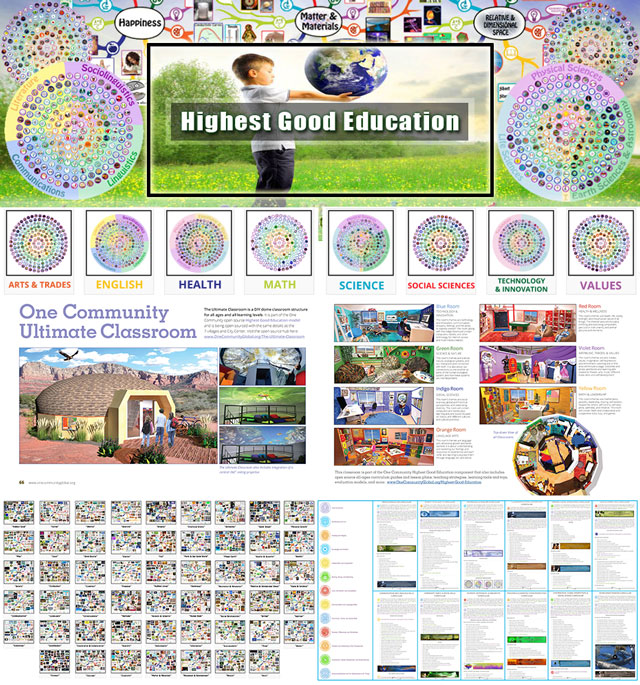
Highest Good Education: All Subjects | All Learning Levels | Any Age – Click image for the open source hub
HIGHEST GOOD SOCIETY PROGRESS
 One Community is creating the world that’s possible through a Highest Good society approach to living that is founded on fulfilled living, the study of meeting human needs, Community, and making a difference in the world:
One Community is creating the world that’s possible through a Highest Good society approach to living that is founded on fulfilled living, the study of meeting human needs, Community, and making a difference in the world:
-
-
- Read the Highest Good society overview: Highest Good Society
- Learn about the model for fulfilled living and sharing: A Day in the Life
- Learn about the 4 economic models: RBE | For-profit | Non-profit | Entrepreneurship
- Learn about our open source community collaboration and management software: The Highest Good Network
-
This week, the core team completed 58 hours managing One Community volunteer-work review not included above, emails, social media accounts, web development, new bug identification and bug-fix integration for the Highest Good Network software, and interviewing and getting set up new volunteer team members. We also shot and incorporated the video above that talks about creating the world that’s possible and how creating the world that’s possible is a foundation of the bigger picture of everything One Community is doing. The pictures below show some of this work. See below for pictures related to this.
Another core team member worked on the Highest Good Network confirming fixes for several PRs, including 1375, 1208+494, 1236, 1391, 494+1208, 561+1371, and PR1775. They also identified issues with PRs 1471, 1371+561, 1368, and 1393+563, reporting discrepancies between the PR descriptions and their actual implementation, particularly regarding report generation and team code formatting. They created a new bug record for fixing the “New Max-Personal Record Award”, related to PR#619. The Highest Good Network software is how we’ll be managing and objectively measuring our process for creating the world that’s possible through our social architecture, construction, production, and maintenance processes. See below for pictures related to their work.
Aaron Wang (Fundraising Assistant) continued to help One Community with working on fundraising. Full funding is needed to begin construction of One Community’s model for creating the world that’s possible. Aaron advanced his in-depth research into connections with Robert Downey Jr., identifying emails and LinkedIn profiles of individuals who may have links to Robert Downey Jr. and his philanthropic contributions. This targeted effort aims to improve the process of engaging with funders by nurturing relationships with pertinent individuals involved in these donations. Aaron’s detailed and strategic approach emphasizes his dedication to effective networking and establishing meaningful connections within the philanthropic sector. You can view this work in the collage below.
Ray Lee (Graphic Designer, Video Editor) helped this week by creating first-draft images for updating our website header to celebrate and acknowledge Women’s History Month and National Volunteer Week at One Community. See the collage image below.
ADMINISTRATION TEAM
The Administration Team’s summary, covering their work administrating and managing most of One Community’s ongoing process for creating the world that’s possible was managed by Vriddhi Misra (Admin and Marketing Assistant) and includes Alyx Parr (Senior Support Specialist), Camilla Okello (Administrative Assistant), Gokul Palanisamy (Data Analyst), Jiaxin Zheng (Data Analyst), Meenakshi Velayutham (Sustainability Associate), Olawunmi “Ola” Ijisesan (Administrative and Management Support), Purva Nantarajesh (Marketing Analyst), Ram Shrivatsav (Data Analyst and Admin assistant), Ruiqi Liu (Administrative Assistant), T R Samarth Urs (Data Analyst) and Xiaolai Li (Administrative Assistant). This week, Alyx optimized the management process for One Community MP3 files obtained from YouTube, renaming the MP3 files to facilitate easy recognition and retrieval of content. She also transformed videos into audio format for the podcast, ensuring a seamless conversion process and maintaining content quality throughout. Camilla completed administrative duties and provided feedback on other admins’ work, while also optimizing her assigned blogs following tutorials. Gokul completed initial training, gained access to the WordPress platform, and uploaded images tailored to content areas to enhance visual appeal and relevance. Jiaxin completed orientation and onboarding tasks, including setting up collaboration software and creating collages, and worked on the SOC team’s weekly review. Meenakshi continued administrative tasks such as checking the weekly summary page and tracking bio announcements, along with reviewing cost analysis details and resolving feedback for infrastructure requirements. Ola reviewed trainees’ work, worked on PR Review teamwork, created collages, and contributed to optimizing the SEO rank score. Purva created collages, performed summary proofreading, assisted newcomers, and optimized previous blog posts for search engines. Ram focused on onboarding training, creating summaries, collages, and a blog post, incorporating feedback from admin mem bers. Ruiqi did her part creating the world that’s possible as she completed the four-step review process for various teams, created collage images, utilized weekly summaries for SEO keywords, and updated SEO on blogs. Samarth completed orientation and setup tasks, participated in Admin team and SEO optimization training, and applied SEO techniques to optimize blog posts. Vriddhi worked on OC Administration tasks for the: Administration, Alpha, Badges Bugs, and Blue Steel Teams. She assigned SEO blogs to team members, reviewed and implemented changes based on team feedback, and worked on Google Analytics and SEO optimization. Xiaolai compiled and submitted Weekly Report 572, assessed the training progress of new team members, updated the webpage, provided assistance to new administrators, and organized documents for the weekly report. You can see the work for the team in the image below.
GRAPHIC DESIGN TEAM
The Graphic Design Team’s summary was managed by Ruiqi Liu (Administrative Assistant) and includes Ashlesha Navale (Graphic Designer) and Jialun Liu (Graphic Designer). Ashlesha focused on creating eight Social Media Images with themes like Cooperation-If We Want To, Cooperation-Idealistic Dream, Cooperation-Humanity Is Ready, Cooperation-Huge Difference, Cooperation-Holistic Living, Cooperation-Higher And Broader Vision, Cooperation-Harmony, and Cooperation-Green Living Solutions. In addition to her design work, she researched and curated a collection of nature-based background images and various theme-based images for the creation of Social Media Images. Jialun worked on a graphic design project, and his works showcased environmental problems and solutions or community actions to improve people’s lives. See the Highest Good Society pages for more on how this relates to creating the world that’s possible. The collage below shows some of this work.
HIGHEST GOOD NETWORK PROGRESS
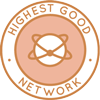 One Community is creating the world that’s possible through open source Highest Good Network® software that is a web-based application for collaboration, time tracking, and objective data collection. The purpose of the Highest Good Network is to provide software for internal operations and external cooperation. It is being designed for global use in support of the different countries and communities replicating the One Community sustainable village models and related components.
One Community is creating the world that’s possible through open source Highest Good Network® software that is a web-based application for collaboration, time tracking, and objective data collection. The purpose of the Highest Good Network is to provide software for internal operations and external cooperation. It is being designed for global use in support of the different countries and communities replicating the One Community sustainable village models and related components.
ALPHA SOFTWARE DEVELOPMENT TEAM
This week, the Alpha Team’s summary, covering their work on the Highest Good Network software, was managed by Sucheta Mukherjee (Software Developer) and includes Chengyan Wang (Software Engineer), Navya M (Full Stack Developer), and Shamim Rahman (Software Engineer). The Highest Good Network software is how we’ll be managing and objectively measuring our process for creating the world that’s possible through our social architecture, construction, production, and maintenance processes. This week, Sucheta focused on reviewing PR1956+750 and PR1979+758, understanding functionality, testing, and approving all functions. Additionally, she played a pivotal role in refactoring the weeklySummary Recipients button functionality to enhance user experience. Meanwhile, Navya spent time on code review and pull request approvals, checking code in the local environment, providing feedback, and scrutinizing Figma screens for task analysis. She also examined Phase 2 documentation and participated in meetings. Shamim completed multiple tasks, including reviewing 11 pull requests, conducting functionality tests, and identifying issues with screenshots. Furthermore, Chengyan addressed technical challenges, resolving UI bugs, eliminating ‘No item data’ issues, and updating the backend and frontend to enhance user experience. See the Highest Good Society and Highest Good Network pages for more on how this relates to creating the world that’s possible. View some of the team’s work in the collage below.
BADGES BUGS SOFTWARE DEVELOPMENT TEAM
The Badges Bugs Team’s summary, covering their work on the Highest Good Network software, was managed by Shaofeng Li (Software Engineer) and includes Renan Luiz Santiago Martins César (Full-stack developer), Xiao Zhang (Software Engineer), and Xiaohan Meng (Software Engineer). The Highest Good Network software is how we’ll be managing and objectively measuring our process for creating the world that’s possible through our social architecture, construction, production, and maintenance processes. This week, Renan implemented disaster recovery in Azure, incorporating both Central US as the primary region and West Europe as the secondary region. He developed the function ‘checkXHrsForXWeek’ to identify potential issues, analyzed components, and performed tests within the application to ensure the proper display of badges, in addition to performing content analysis and resource identification to support the implementation of logic. He identified and resolved a bug related to deleting usernames upon account deletion and is currently working on implementing the solution, alongside investigating the absence of 30-week hours in one week for potential solutions. Shaofeng helped with creating the world that’s possible as he engaged in a range of activities for the HGN Software Development project, starting with tests on the front-end system to identify necessary fixes, facilitated a team meeting to outline the week’s plan and assisted team members with technical obstacles, involved code modifications to the front-end components. He saw an effort in resolving the “90 hours in one week badge not being awarded” issue, with bug fixes in the front-end parts and conducting unit tests, tallying up to 5 hours. He also aimed to ensure both front-end and back-end functionality were aligned, investigating the log time functionality as a potential factor in the badge assignment problem. Xiao concentrated on optimizing their project by creating a function to efficiently allocate X hours within a single week, splitting the existing XHoursForXWeeks function into two separate entities, which simplified the code, making it more intuitive and easier to manage. Xiaohan reviewed the “HGN Phase I Bugs and Needed Functionalities” and “HGN Software Team Management” documents, and acquired an understanding of the protocols for submitting a pull request (PR), the associated procedures, and HGN management’s requirements. He configured and operated the front-end and back-end environments locally without complications, and following requests from Jae and Nahiyan_Add, Xiaohan undertook reviews of specific PRs, finding significant issues concerning component overlap and a backend terminal issue related to the profile picture upload functionality. See the Highest Good Society and Highest Good Network pages for more on how this relates to creating the world that’s possible. Look below for pictures of the team’s work.
BLUE STEEL SOFTWARE DEVELOPMENT TEAM
The Blue Steel Team’s summary, covering their work on the Highest Good Network software, was managed by Nathan Hoffman (Software Engineer, Team Manager) and includes Alex Brandt (Full Stack Developer), Jingyi Jia (Software Engineer), Shiqing Pan (Full-Stack Software Developer), Swathy Jayaseelan (Software Engineer), Tzu Ning “Leo” Chueh (Software Engineer), and Xiao Wang (Software Engineer). This week, Alex started working in a developer role, working on two pull requests, PR #646 for the back end and PR #1562 for the front end. To resolve a testing bug, he researched the Provider and Connect APIs for Redux and made edits to the styling of the front-end prompt buttons. Finally, on the back end, he configured their own OpenAI API key. Jingyi completed the development of the “rehireable / Not rehireable” checkbox feature, implemented on both the user profile page and in the reports/people reports/user profile section of the platform. Following thorough testing in a local environment, where the feature performed as expected without any issues, Jingyi submitted two pull requests for review: PR 2032 and PR 789. Nathan reviewed team members’ weekly summaries and videos, offering constructive feedback to foster improvement. Additionally, he reviewed Jay’s pull requests, clarifying requirements for password and task X permissions with Jae. In-depth review of Jay’s pull requests also involved addressing issues related to editing time log dates and requesting necessary changes for refinement. Shiqing tackled the problem of users needing to be part of a team to view their tasks. She reviewed the comments in the pull requests made by colleagues and made necessary code modifications. Utilizing useEffect, she monitored the userHaveTask status to indicate whether tasks were assigned to a user and directly updated the activeTab variable within the timeLogState as soon as any data change occurred. Additionally, Shiqing enhanced the Teams component by implementing further tests for adding, deleting, and updating team information. She also spent time debugging previous tests on this component, ensuring functionality and reliability were maintained. Swathy did her part helping with creating the world that’s possible as she expanded the unit test coverage for the codebase, completing a unit test file and submitting a pull request for review and integration. She then began testing the UserProfile -> Teams Table component but encountered challenges in creating reliable test cases. After troubleshooting, Swathy identified a configuration issue within the file and is currently researching solutions through online documentation, and writing test cases to verify the component’s functionality. Tzu Ning checked out the current branch, cleared the site data and cache, then logged in as an admin user and tested the Google Doc link by entering various URLs to verify that only Google Doc links are allowed. Additionally, he confirmed that any valid URL could be entered in the Media Folder link, ensuring the functionality aligns with the intended design and requirements. Xiao assisted Shereen in testing the time entry history feature, identifying a critical limitation: due to permissions constraints, users lacking ‘edit time entry’ access are unable to modify time entry details, leading to unchangeable history records. Additionally, he supported Mohammad with a refactoring issue related to accessing the state in the Redux store, providing guidance on best practices for state management. Xiao also contributed to resolving a failing test case issue for Christy, advising on modifications to test scenarios to ensure success. In another instance, he helped Demi troubleshoot a visibility problem with her page, which was traced back to a time entry logged against a task she was not assigned to. Furthermore, he implemented a pull request to enhance the Timer’s resilience to poor internet connectivity by allowing up to three failed connection attempts before a heartbeat failure is declared, aiming to improve user experience in low-bandwidth situations. The Highest Good Network software is how we’ll be managing and objectively measuring our process for creating the world that’s possible through our social architecture, construction, production, and maintenance processes. See the Highest Good Society and Highest Good Network pages for more on how this relates to creating the world that’s possible. The collage below shows some of this work.
CODECRAFTERS SOFTWARE DEVELOPMENT TEAM
The Code Crafters Team’s summary, covering their work on the Highest Good Network software, was managed by Anirudh Ghildiyal (Software Engineer) and includes Anirudh Dutt (Software Developer), Ramya Ramasamy (Software Engineer), Shantanu Kumar (Software Developer), Shengjie Mao (Software Engineer), Sophie Lei (Software Engineer), and Tapan Pathak (Software Engineer). The Highest Good Network software is how we’ll be creating the world that’s possible through our social architecture, construction, production, and maintenance processes. Anirudh D engaged in unit testing, and PR reviews, collaborating with Diego on creating a permissions constant file in the frontend utils to eliminate hardcoded permissions. Anirudh G created and prepared to review Pull Request #2040 for the UserTeamProjectContainer component, also reviewing tasks from teammates Shantanu, Sophie, Ramya, and Nahiyan. He ensured passing test cases for the UserTeamProject component, submitted final unit test cases for SetUpFinalDayPopUp, and continued writing unit test cases for the UserTeamProjectContainer. Ramya addressed a high-priority bug in PR 1905, ensuring correct usage of deep copy for the useState variable, and began writing unit test cases for the larger ReportPeopleTableDetail component. Shantanu wrote test cases for the weekly summary component, created dummy data for unit tests, and resolved conflicts for the “make button more efficient” pull request. Shengjie worked on a unit test file for the BMLogin component, facing errors during implementation and seeking group assistance. Sophie did her part helping with creating the world that’s possible as she focused on resolving color discrepancies in the People Report’s Pie Chart, utilizing the D3 library, and implementing mouseover and mouseout effects for improved user interaction. Tapan addressed a UI bug related to creating a new role, encountering challenges in pushing the branch to the frontend git repository and collaborating with Jae and Renan for resolution. See the Highest Good Society and Highest Good Network pages for more on how this relates to creating the world that’s possible. The collage below shows some of this work.
EXPRESSERS SOFTWARE DEVELOPMENT TEAM
The Expressers Team’s summary, covering their work on the Highest Good Network software, was managed by Ruiqi Liu (Administrative Assistant) and includes Aishwarya Kalkundrikar (Full Stack Software Developer), Christy Guo (Software Engineer), Ilya Flaks (Software Engineer), Kevin Hinh (Software Engineer), Shereen Punnassery (Full Stack Software Engineer), and Mohammad Abbas (Software Engineer). The Highest Good Network software is how we’ll be creating the world that’s possible through our social architecture, construction, production, and maintenance processes. Aishwarya led the update of the Reusable-Bulk frontend, completing the coding of components for UpdateReusableBulk, its inputs, and the display table, along with finalizing the API route. She also revisited an old pull request related to equipment view, addressing intermittent issues reported by users. Christy did her part helping with creating the world that’s possible as she implemented the 3D bar chart into the project’s reporting page and resolved issues from PR1985. She continued work on the frontend purchase form and backend routing components for the “Purchase Equipment” feature. Ilya developed the backend for “Tools List Default View” and addressed feedback from Diego Salas on a previous Pull Request #2010. He also discussed with Mohammad about Redux nuances and troubleshooting. Kevin focused on backend tasks for the BMDashboard timelog component, setting up websockets to ensure proper timelog incrementation. Mohammad integrated frontend and backend components, ensuring system cohesion, and improving the WBS user interface. Shereen tested for the TimeEntryHistory component, addressing Redux mock store issues and ensuring proper rendering for testing purposes. See the Highest Good Society and Highest Good Network pages for more on how this relates to creating the world that’s possible. The collage below shows some of this work.
GIT-R-DONE SOFTWARE DEVELOPMENT TEAM
The Git-R-Done Team’s summary, covering their work on the Highest Good Network software, was managed by Ruiqi Liu (Administrative Assistant) and includes Sai Deepak Dogiparthi (Software Developer), Chris Chen (Software Engineer Intern), Miguelcloid Reniva (Software Developer), Nidhi Galgali (Software Developer), Rhea Wu (Software Engineer), and Shuhua Liu (Full-Stack Developer). The Highest Good Network software is how we’ll be creating the world that’s possible through our social architecture, construction, production, and maintenance processes. Chris developed a React component for updating tools or equipment, incorporating React hooks and Redux for state management, Bootstrap for styling, and creating a user interface with form inputs for status updates, last user details, and notes. He also implemented error handling and a modal component for additional user interactions. Miguel did his part helping with creating the world that’s possible as he addressed styling issues, sought clarification on a dropdown menu’s functionality, and troubleshooted a display bug affecting item numbers’ visibility on smaller screens. Nidhi finalized unit tests for the BMDashboard component, started a pull request for integration, and prepared for the Equipment Details Page backend task by familiarizing herself with the HGN Phase II document. Rhea advanced the pull request related to Issue Schema and New Issue Routing, addressing comments and preparing for testing and new tasks. Deepak focused on the backend and partially on the frontend of the equipment details page, leading the weekly meeting, assigning tasks, and addressing a minor data retrieval issue by referring to the material details page. Shuhua incorporated the Manager Icon into the Team Member Tasks Tab, exploring MongoDB aggregation pipelines to generate member role information from two collections: teams and user profiles. See the Highest Good Society and Highest Good Network pages for more on how this relates to creating the world that’s possible. The collage below shows some of this work.
MOONFALL’S SOFTWARE DEVELOPMENT TEAM
Moonfall Team’s summary, covering their work on the Highest Good Network software, was managed by Lu Wang (Software Engineer) and includes Abdelmounaim “Abdel” Lallouache (Software Developer), Cheng-Yun Chuang (Software Engineer), Haoji Bian (Software Engineer) and Jiadong Zhang (Software Engineer). The Highest Good Network software is how we’ll be managing and objectively measuring our process for creating the world that’s possible through our social architecture, construction, production, and maintenance processes. Lu focused on debugging and enhancing test coverage for critical components, including the AddTaskModal, EditTaskModal, and ImportModal files. Abdel did his part helping with creating the world that’s possible as he troubleshot issues related to PR 2009 and 779 and rebuilt the blue square scheduler. Cheng-Yun implemented front-end sorting function and UI for sorting buttons on inventory and member projects and initiated Pull Request #2034. Haoji did his part helping with creating the world that’s possible as he worked on enhancing user accessibility, optimizing system performance, and refining cronjob setup. Jiadong updated the dashboard’s badge system, addressing bugs and improving badge assignment functionality. See the Highest Good Society and Highest Good Network pages for more on how this relates to creating the world that’s possible. Look below for a collage of their work.
REACTONAUTS’ SOFTWARE DEVELOPMENT TEAM
Reactonauts’ Team’s summary, covering their work on the Highest Good Network software, was managed by Masasa Thapelo (Software Engineer) and includes Changhao Li (Software Engineer), Peterson Rodrigues (Full-Stack MERN Stack Developer), Shengwei Peng (Software Engineer), Shiwani Rajagopalan (Software Engineer), Vikram Badhan (Software Engineer), Yi Feng (Full-Stack Software Engineer) and Yixiao Jiang (Software Engineer). The Highest Good Network software is how we’ll be managing and objectively measuring our process for creating the world that’s possible through our social architecture, construction, production, and maintenance processes. Masasa managed the group by hosting the weekly meeting, drafting team summaries, and progressing on the permissions task for the user management page. Shiwani focused on two tasks, namely refining the leaderboard indicator and completing unit tests for UserRoleTab. She restructured the logic for the leaderboard, introduced a ‘TimeOffCalculate’ function for time-off indicators, and initiated code optimization. Changhao did his part helping with creating the world that’s possible as he delved into React-Redux and Jest documentation, addressing issues related to incorrect rendering in a test component and reporting progress to the team manager. Yi joined the development team, completing three tasks, with one pull request merged and two under review. Yixiao resolved issues, merging development, and working on component header code. Vikram did his part helping with creating the world that’s possible as he focused on unit testing for WeeklySummaryOptions.jsx and ToggleSwitchContainer.jsx, ensuring component functionality and reliability, while also contributing to pull request reviews. Jiadong updated the dashboard’s badge system, addressing a bug in the badge number indicator, refining badge assignment processes on both frontend and backend for improved accuracy. Peterson took on the task of implementing a filter for “Team Member Tasks” and “Leaderboard” tables, addressing a bug related to improper useState usage, and progressing with the ongoing filter implementation. Shengwei finalized the “NEW USER” function and eliminated the addition of the blue square. See the Highest Good Society and Highest Good Network pages for more on how this relates to creating the world that’s possible. Look below for pictures of this work.
SKYE’S SOFTWARE DEVELOPMENT TEAM
Skye’s summary, covering their work on the Highest Good Network software, was managed by Luis Arevalo (Front End Developer) and includes Jerry Ren (Full Stack Developer), Jiarong Li (Software Engineer), John Mumbi (Developer), Roberto Contreras (Software Developer) and Yao Wang (Software Engineer). The Highest Good Network software is how we’ll be managing and objectively measuring our process for creating the world that’s possible through our social architecture, construction, production, and maintenance processes. John optimized the loading speed of the weekly summaries reports page by performing refactoring on components and integrating a pagination component, resulting in a notable enhancement in page performance. Jerry did his part helping with creating the world that’s possible as he added a unit test for detecting duplicate roles and planned implementation of a method to clear dispatched actions for another task. Yao did his part helping with creating the world that’s possible as he started working on improving the loading speed of the profile page. Roberto resolved identification mix-up issues, addressed backend errors, investigated frontend discrepancies, and worked on updating pull requests. Jiarong revised the codebase of the HighestGoodNetworkApp project, enhancing functionality and code efficiency, resolving conflicts, and collaborating with Luis to debug and update components. Luis finalized the add/delete warnings component, refactored the cluttered modal by dividing it into two modals, which improved the codebase, and ensured all features worked and integrated with the existing warnings component. See the Highest Good Society and Highest Good Network pages for more on how this relates to creating the world that’s possible. See the collage below for some of their work.
SOFTWARE PR REVIEW TEAM
The PR Review Team’s summary covering their work on the Highest Good Network software was managed by Olawunmi Ijisesan (Administrative and Management Support). The Highest Good Network software is a foundation of what we’ll be using to measure our results of creating the world that’s possible. This week’s active members of this team were: Aaron Persaud (Software Developer), Bhuvan Dama (Full Stack Developer), Carl Bebli (Software Developer), Cooper Bjorkelund (Frontend developer), Dhairya Mehta (Software Engineer), Diego Salas (Software Engineer), Gabriele Canova (Frontend Developer), Hetvi Patel (Full Stack Developer), KaiKane Lacno (Software Developer and Team Manager), Kurtis Ivey (Software Engineer), Meet Padhiar (Software Engineer), Mengtian Chen (Software Engineer), Nnamdi Ikenna-Obi (Software Engineer), Olga Yudkin (Software Engineer), Pratima Singh (Software Developer), Priyanka Sharma (Software Engineer), Raj Nada (Software Developer), Sanket Kaware (Full stack developer), Sarthak Jaiswal (Full Stack Developer), Tim Kent (Full Stack Software Engineer), Weiyao Li (Software Engineer), Yaohong Xiang (Software Engineer), and Zijie “Cyril” Yu (Software Engineer). They reviewed all the Highest Good Network PRs (Pull Requests) shared in this week’s update. Learn more about how the Highest Good Network will measure and assist in creating the world that’s possible in the Highest Good Network open source hub. The collage below shows a compilation of the work from this team.
AND WE PRODUCED THIS WEEKLY UPDATES BLOG – CLICK HERE TO SUBSCRIBE
FOLLOW ONE COMMUNITY’S PROGRESS (click icons for our pages)
INVESTOR PAGES
 One Community
One Community


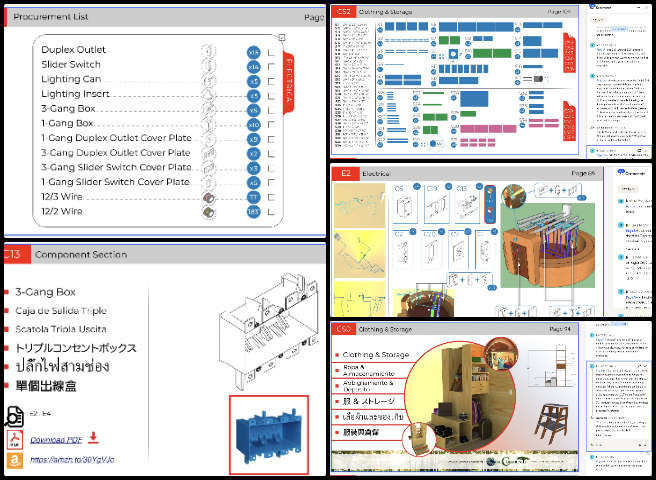
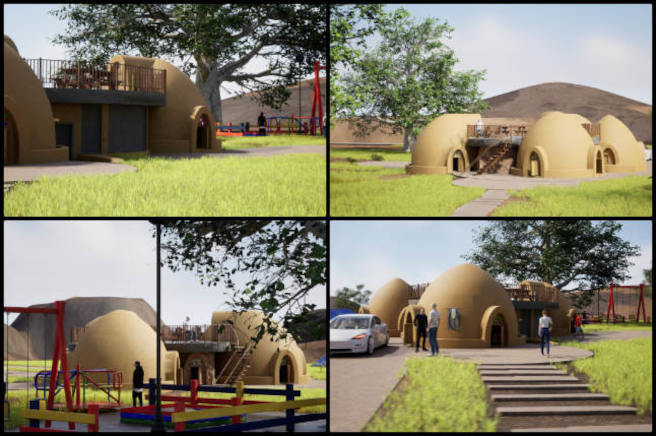
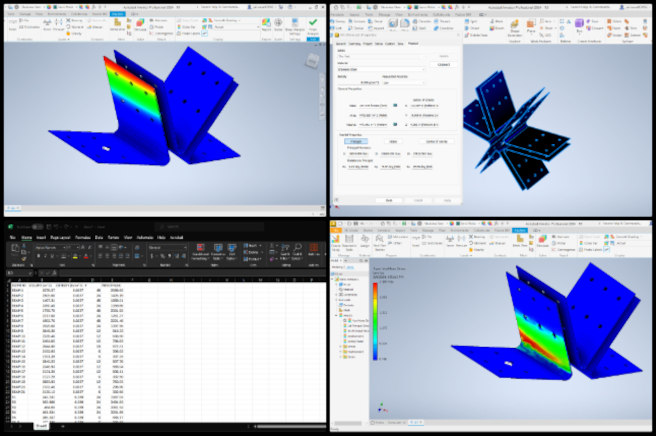
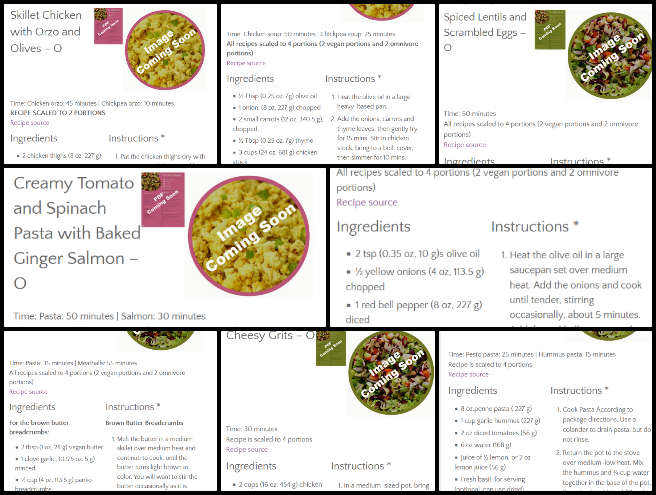
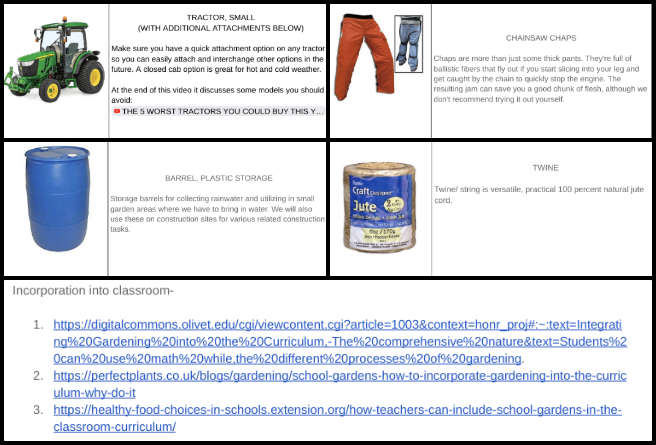
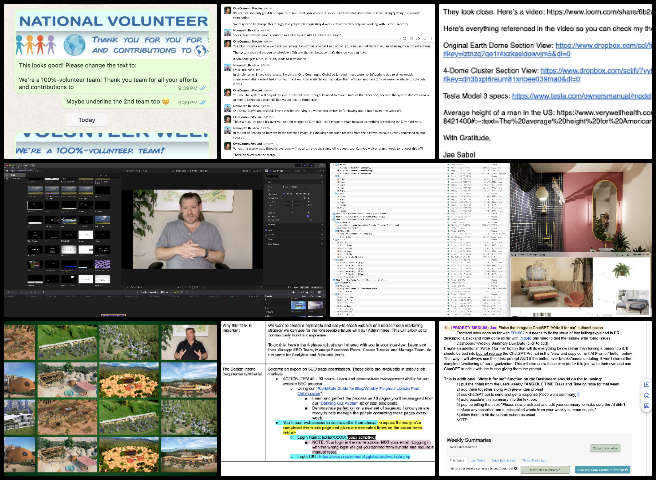
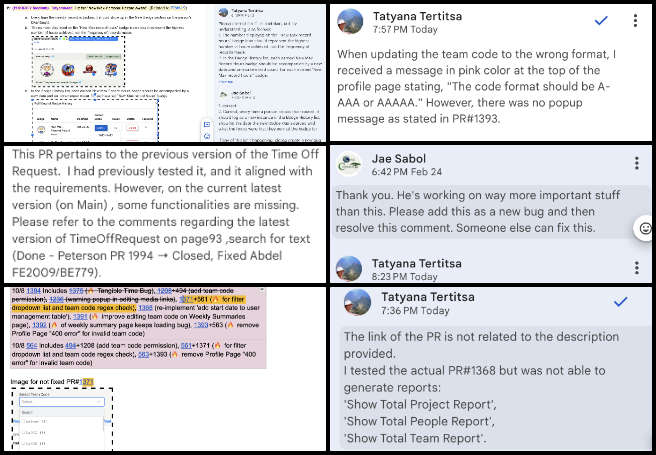
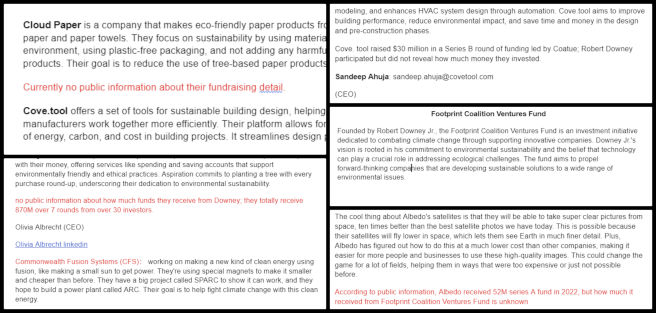
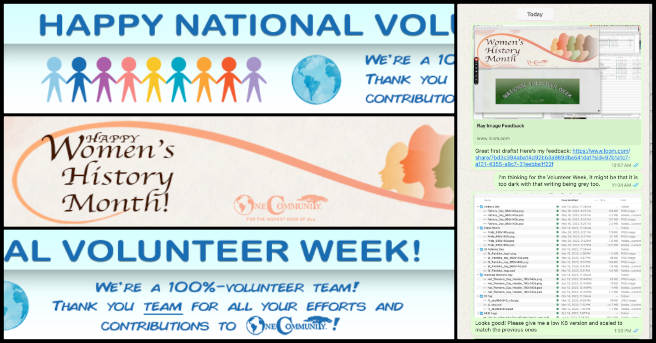
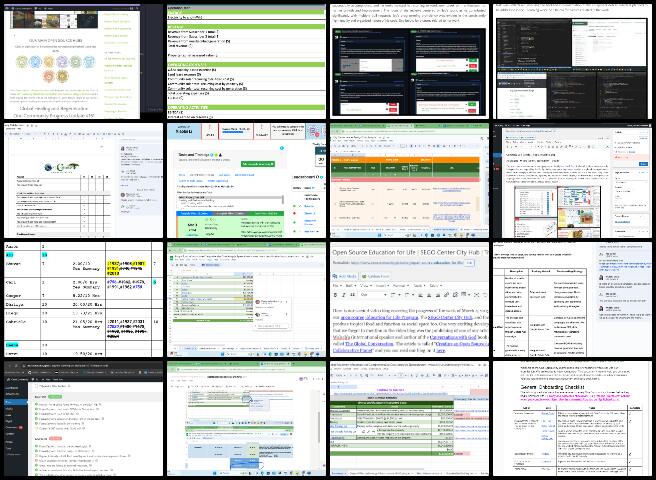
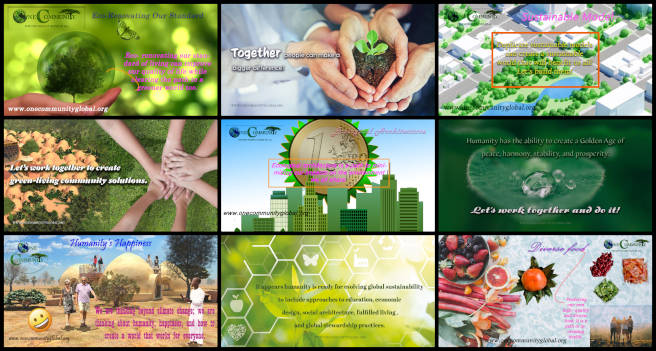
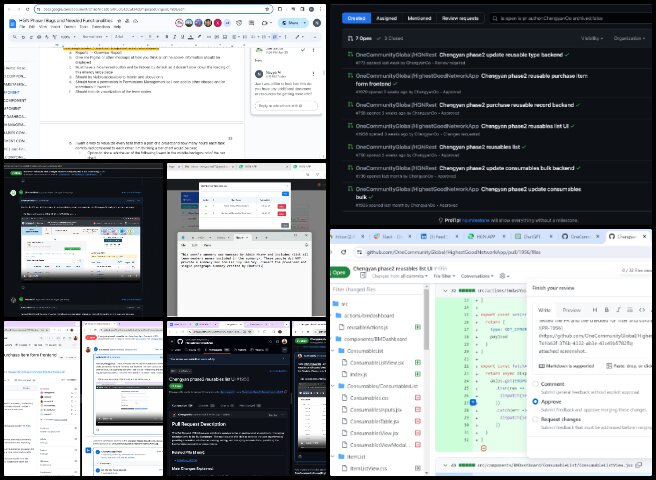
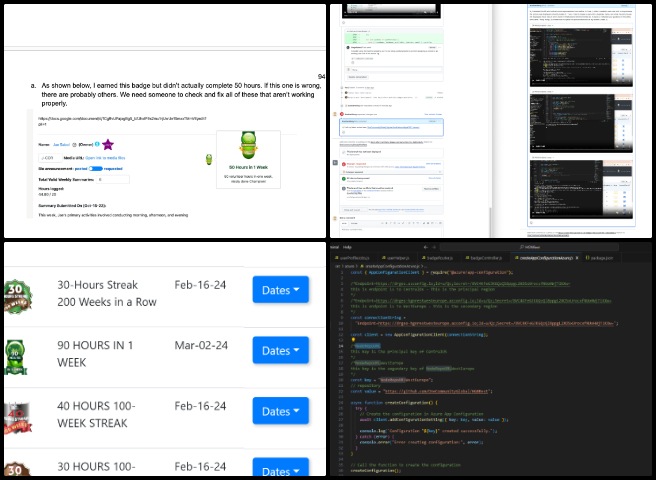
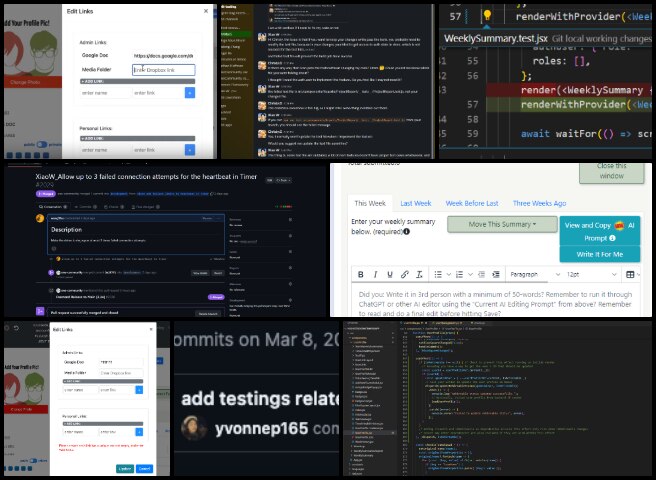
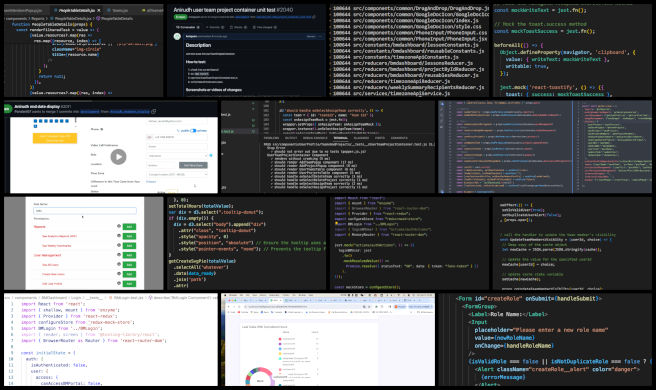
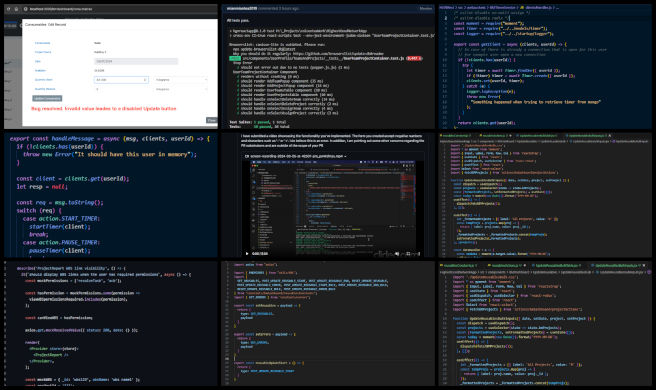
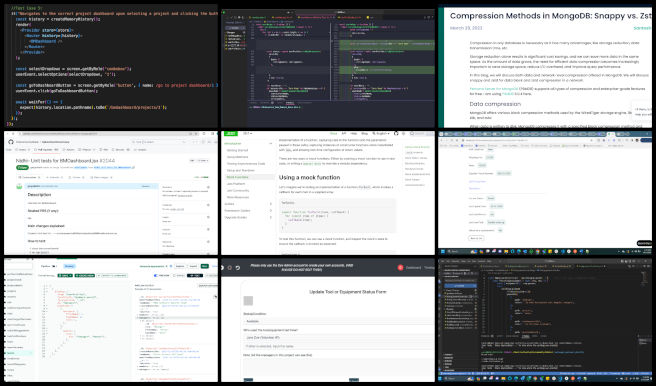
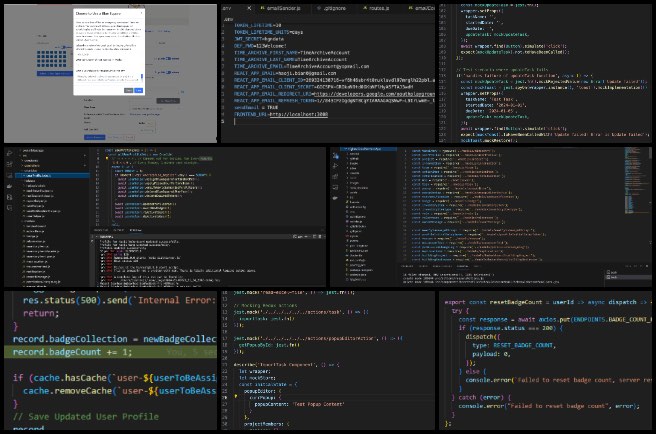
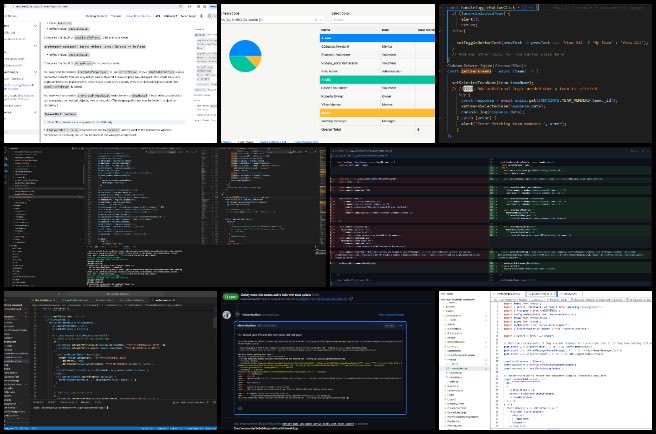
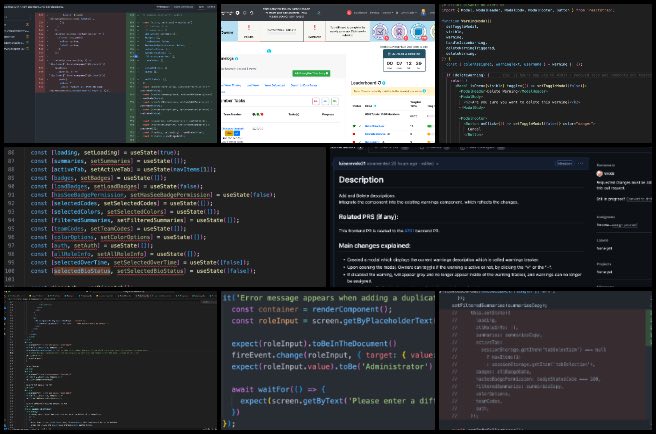
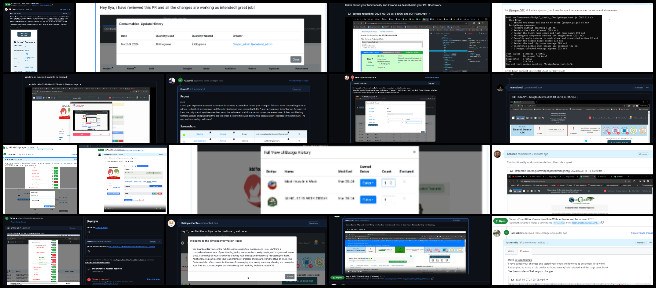



Connect with One Community